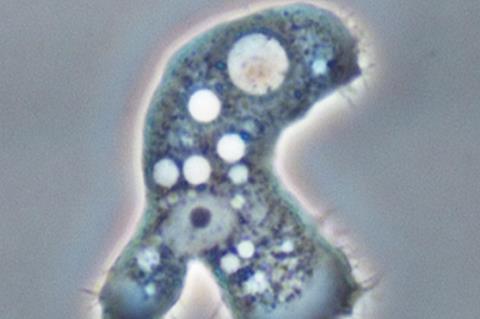Just as the human body serves as a habitat for bacteria and other microbes, diverse, tiny organisms known as protists host their own microbiomes.

In new research published in the journal Cell Host & Microbe this week, a team led by Marine Biological Laboratory (MBL) scientists reveals that symbiotic bacteria often accompany single-celled protists in the ocean’s upper layer. Some of these symbionts, they discovered, are close relatives of bacteria pathogenic to animals, including humans.
“We know there are many symbionts in the world, but it was surprising to find that smallest, and most common predatory protists in the ocean have symbionts living with them,” says senior author Alexandra Worden, a senior scientist at MBL.
The protists her team studied are among the smallest in the ocean, measuring two to five microns, roughly the size of a dust particle or small mold spore. The discovery of these symbiont lineages sheds light on the evolution of their bacterial relatives – whether symbionts or pathogens – insight that could help researchers understand disease vectors and the infections they cause in people.
Marine protists are elusive – and essential
Protists are a diverse, catchall group. Most are unicellular, but with features that disqualify them from grouping with other types of life like animals, plants, fungi, bacteria, and archaea.
In the ocean, some protists function like plants, using light to manufacture their own food. Others, such as choanoflagellates, which are animals’ closest living unicellular relatives, envelop and digest still smaller cells. Ocean ecosystems depend on these predators and browsers to consume plant-like phytoplankton and other bacteria, and, in turn, become food for the tiny marine animals that fish eat.
READ MORE: Mysteries of the arm-swinging protist Meteora sporadica uncovered
READ MORE: Predatory soil protists may boost PGPB activity
Scientists have had difficulty studying their contribution to marine food webs, in part because they can’t coax these organisms to grow in the lab. To get around this problem, Worden developed a method for examining individual protist cells fresh out of the ocean using equipment brought onto research vessels – rather than in stable, climate-controlled rooms in hospitals and research centers, as usual.
“It has been an incredible team effort by students, technicians, and postdocs in the lab over the years to make these discoveries. A lot of perseverance and work within the constraints of the expeditions and weather!” she says.
Studying the protists physiology
After retrieving water samples from the North Pacific and other locations, researchers in her group stain the protists’ food vacuole — equivalent to their stomachs. This stain makes it possible to select the protists that interest the researchers: those eating other things. After separating out the individual protists, the researchers then identify the bacteria within or attached to them using genetic sequencing. (Their analysis looked only at whole bacteria, not the ones the protists had recently eaten.)
Then they worked with collaborators in the BIOS-SCOPE project, taking what they had learned to analyze data collected on a monthly basis over multiple years in the North Atlantic, in order to understand seasonal dynamics.
Studying these symbionts is essential to fully understanding the protists’ biology, similar to how the human microbiome is crucial to our health, according to Worden. “They could be fundamental to how the protists live and grow in the ocean,” she says.
Symbiosis in protists and in humans
Unlike the human microbiome, which hosts trillions of symbiont cells, the much smaller protists can likely carry a small handful.
In the research published in Nature Microbiology in 2022, Worden’s team used on-board cell sorting to identify one type of bacterial symbiont, dubbed Comchoano, within a species of choanoflagellate. It and four other groups of bacteria showed up within the many protist cells analyzed for the present study. Of the four new symbiont lineages, three have close evolutionary links to human pathogens that live as symbionts in insects, such as ticks.
One of these lineages is closely related to Coxiella, a group that contains the germs responsible for the flu-like Q fever. Meanwhile, the others belong within a group that includes Rickettsia, members of which can cause Rocky Mountain spotted fever, typhus, and other infections.
In spite of their links to disease in mammals, it’s not clear if these microbes help or harm their protist hosts. Context makes all the difference in these relationships, says Worden, noting that bacteria such as Rickettsia aid their insect hosts, only causing disease once they arrive within humans or other mammals.
“There’s an arc from our symbionts, all the way to disease in humans,” says first author Fabian Wittmers, who conducted the research while a BIOS-SCOPE graduate student in Worden’s Lab.







No comments yet